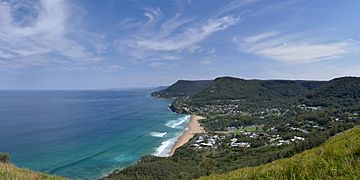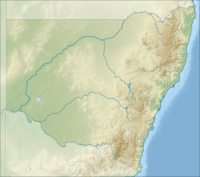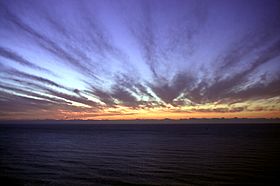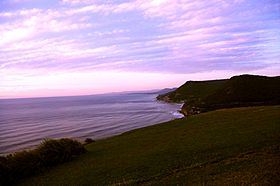Bald Hill (Australia) facts for kids
Quick facts for kids Bald Hill |
|
|---|---|

Stanwell Park and its beach as seen from Bald Hill looking south towards the Sea Cliff Bridge and Wollongong.
|
|
| Highest point | |
| Elevation | 300 m (980 ft) |
| Geography | |
| Parent range | Illawarra |
Bald Hill is a famous lookout point in New South Wales, Australia. It's a hill on the Illawarra Range, about 300 meters (984 feet) above sea level. From here, you can see amazing views of the Illawarra area, including the ocean and the green hills.
This spot is super popular for hang gliding and paragliding. It's even known around the world for these sports! A long time ago, an Australian flight pioneer named Lawrence Hargrave experimented with his special box kites right on the beach below Bald Hill. There's a memorial built for him at the top of the hill, near the car park.
Contents
Exploring Bald Hill's Geography
Bald Hill is like a tall headland, marking the northern end of the Illawarra escarpment. Just north of Bald Hill is a place called Stony Batter. It's a sandstone rock formation with great views too. You can reach it by a track that goes into the Royal National Park. The coastal ridge continues north, forming other hills like Otford and Bulgo. The escarpment itself turns into the white cliffs of the Royal National Park.
From the Bald Hill lookout, you get a full 360-degree view. To the northwest, you can see Stanwell Tops and the Royal National Park. To the far north, you'll spot the white cliffs of the Royal National Park. Look east, and you'll see the Tasman Sea of the South Pacific Ocean stretching out. To the south, you can see Stanwell Park and Mount Mitchell, and the Illawarra escarpment going all the way to Saddleback Mountain.
History of Bald Hill and Stanwell Park
Bald Hill has a rich history, from its first people to European settlement and important flight experiments.
First People of Bald Hill
The original owners of the land around Bald Hill are the Australian Aboriginal Tharawal people. They have lived here for thousands of years.
European Settlement and Lawrence Hargrave
In 1832, Bald Hill was given to Matthew Gibbons. Later, it was bought by Campbell Mitchell. In 1871, Mitchell leased part of his land to Justice John Fletcher Hargrave, who was the father of Lawrence Hargrave. When Mitchell faced financial difficulties, Justice Hargrave bought more land, including Otford, Stanwell Park, and the Coal Cliffs.
Lawrence Hargrave lived at a house called 'Hillcrest' from 1893 to 1899. This is where he worked on many of his flying machines, including monoplanes and cellular kites. His most famous achievement happened on November 12, 1894. He was lifted 16 feet (about 5 meters) into the air on Stanwell Park Beach using a series of four box kites he had designed. Hargrave's work on box kites was very important for the development of airplane wings.
On August 3, 1940, a memorial for Lawrence Hargrave was put up on Bald Hill. It overlooks the area where he did his experiments. The monument has a bronze plaque with a picture of Hargrave and explains his important work in flight.
A Popular Tourist Spot
Bald Hill is a very popular place for tourists. People come here to enjoy the views, and especially for hang gliding and paragliding. Safety has been greatly improved for these activities over the years. Bald Hill (also known as Lawrence Hargrave Memorial Park) is recognized as an important historical site.
The name "Bald Hill" might be a bit misleading now, as more plants and grasses are growing on its slopes. There are toilets, a car park, and even sculptures, including one showing a hang glider. Many motorbike groups also stop here on their tours. You can get to the lookout by driving along Lawrence Hargrave Drive.
Every November, the Stanwell Park Festival of Flight is held. This festival celebrates Lawrence Hargrave's amazing achievements in flight.
Images for kids






